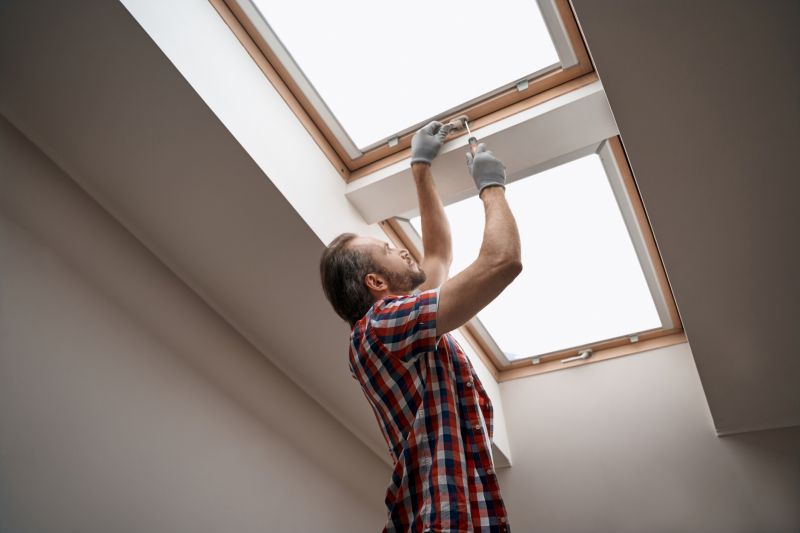Essential Products For Skylight Sealing To Prevent Water Damage
Identify the key sealing materials that effectively block water intrusion and extend the lifespan of your skylights.
 Skylight sealing products are essential components for maintaining the integrity and energy efficiency of a home or building. They help prevent leaks, drafts, and water infiltration around skylights, which are often vulnerable points in roofing systems. Selecting the right sealing products can extend the lifespan of the skylight installation, reduce maintenance needs, and improve indoor comfort. Various types of sealants and accessories are available to suit different skylight designs, roofing materials, and installation requirements.
Skylight sealing products are essential components for maintaining the integrity and energy efficiency of a home or building. They help prevent leaks, drafts, and water infiltration around skylights, which are often vulnerable points in roofing systems. Selecting the right sealing products can extend the lifespan of the skylight installation, reduce maintenance needs, and improve indoor comfort. Various types of sealants and accessories are available to suit different skylight designs, roofing materials, and installation requirements.
Top Overall Option
Flexible Weatherproof Sealant Tape
A versatile and durable sealant tape designed for various skylight sealing applications. It offers excellent adhesion to different roofing materials, remains flexible over time, and provides a reliable barrier against water and air infiltration. Its ease of installation makes it suitable for both DIY projects and professional repairs, ensuring long-lasting performance in diverse weather conditions.
Types of Products For Skylight Sealings
Butyl Rubber Sealant
A flexible, adhesive sealant ideal for sealing around skylights and flashing. It adheres well to metal, plastic, and roofing materials, providing a weather-resistant barrier.
Silicone Sealant
A high-performance sealant suitable for sealing gaps and joints around skylights. It remains flexible and resistant to UV rays and temperature changes.
Acrylic Caulk
An easy-to-apply caulk that offers good adhesion and weather resistance. Suitable for interior and exterior sealing around skylights.
Polyurethane Sealant
A durable sealant that provides strong adhesion and elasticity. Ideal for sealing larger gaps and joints.
Weatherproof Tape
Self-adhesive tapes designed to create a waterproof seal around skylights. Available in various widths and thicknesses for different applications.
Butyl Tape
A flexible, sticky tape used for sealing seams and flashing around skylights. It offers excellent waterproofing properties.
EPDM Rubber Membrane
A synthetic rubber membrane used for waterproofing skylight flashing and sealing large gaps. Known for its durability and weather resistance.
Flashing Tape
Specialized tape for sealing flashing and edges around skylights, ensuring a waterproof barrier.
Roof Sealant Spray
A spray-on sealant that can be applied to small cracks and joints for quick sealing around skylights.
EPDM Adhesive Sealant
A sealant designed for bonding EPDM rubber components and sealing seams in skylight installations.
Butyl Cord
Pre-formed butyl cords used for sealing around skylight frames and flashing joints.
Polyethylene Sheet
A protective sheet used during sealing and repair processes to provide a waterproof barrier.
Foam Weatherstripping
Flexible foam strips used to seal gaps and prevent drafts around skylight frames.
Popular Choices
Widely used for quick repairs and sealing around skylights, offering strong adhesion and waterproofing.
A common choice for long-lasting sealing, appreciated for its flexibility and weather resistance.
Popular for its reliable adhesion and waterproof qualities, suitable for sealing joints and flashing.
Effective for sealing flashing and edges, helping to prevent water infiltration around skylights.
A versatile option for sealing small gaps and cracks, easy to apply and clean up.
Chosen for its durability and weatherproofing capabilities in sealing large or complex skylight installations.
Often used for sealing larger joints, appreciated for its elasticity and adhesion strength.
Convenient for DIY repairs, providing a waterproof barrier with simple application.
Popular for sealing around frames to prevent drafts and improve insulation.
Used for sealing seams and joints, offering a reliable waterproof seal around skylight frames.
Proper sealing not only enhances the durability of the skylight but also contributes to better insulation, helping to regulate indoor temperatures and reduce energy costs. When choosing sealing products, it is important to consider factors such as compatibility with roofing materials, weather resistance, ease of application, and longevity. Whether you are undertaking a new installation or resealing an existing skylight, the right products can make a significant difference in performance.
Many sealing solutions are designed to withstand harsh weather conditions, including rain, snow, and temperature fluctuations. They often come in various forms such as tapes, caulks, butyl rubber, and specialized sealant tapes. It is advisable to select products that are UV resistant and flexible to accommodate building movements without cracking or losing adhesion. Proper surface preparation and application are crucial for achieving optimal sealing results and ensuring long-term protection.
Investing in quality skylight sealing products can help prevent issues like water damage, mold growth, and energy loss. Regular inspection and maintenance of skylight seals are recommended to identify and address potential problems early. By choosing the appropriate sealing solutions, homeowners and contractors can ensure that skylights remain functional, weatherproof, and visually appealing for years to come.
Key Buying Considerations
- Compatibility with roofing materials and skylight frame materials
- Weather resistance, including UV stability and waterproofing capabilities
- Flexibility and elasticity to accommodate building movements
- Ease of application, especially for DIY projects
- Longevity and durability under various environmental conditions
- Adhesion strength to different surfaces
- Compatibility with existing sealants or flashing materials
- Resistance to mold, mildew, and mildew growth
- Ability to withstand temperature fluctuations without cracking or losing adhesion
- Ease of removal or reapplication if repairs are needed
- Non-corrosive properties to avoid damaging metal or other materials
- Availability in various sizes and forms to suit different sealing needs
- Cost-effectiveness over time considering durability and performance
- Certification or compliance with relevant building standards
This page contains affiliate links. Purchasing through these links may earn a commission at no additional cost to you.
